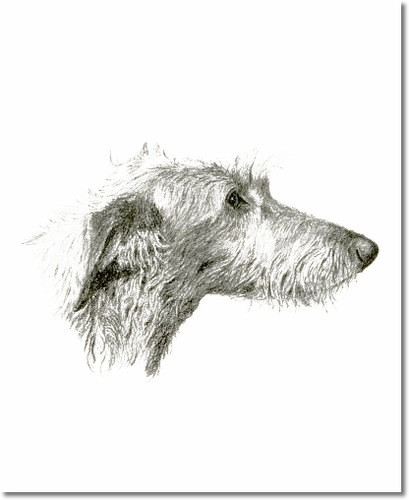
It’s not conjecture: The Scottish Deerhound existed before recorded history. Archeological evidence in the way of Roman pottery found in Argyll in western Scotland, and standing stones, such as the Hilton of Cadboll Stone, suggest that dogs closely resembling Deerhounds existed around the first century.
Descriptive names for these dogs, names such as “Scotch Greyhound,” “Rough Greyhound,” and “Highland Deerhound” identified the purpose, rather than the species of dog, but drawings leave little doubt what they were. Hounds, typically a pair of them, were “slipped” to course and dispatch the deer. Later, with the introduction of firearms, they were used to track deer, or follow a wounded one to bring it to bay.
Soon, the term, ‘Deerhound” was applied to the dogs specifically suited for the pursuit and killing of deer. In the 16th century, Hector Boece’s, the “History of Scotland” contains what many believe to be the earliest mention of the Scottish Deerhound.
Deerhounds were so highly regarded that in the Middle Ages, only royalty and nobility could own a Scottish Deerhound, and this exclusive ownership endangered the continuance of the breed. Game became harder to find in England,and Greyhounds soon took the place of larger Deerhounds. In Scotland, Highland Chieftains initially assumed exclusive ownership of the dogs, but with the collapse of the clan system after Culloden in 1745, things looked dire for the breed.
As Deerhounds reached a critically low state in numbers, a few gentlemen’s kennels did work to preserve the breed. Two brothers, Archibald and Duncan McNeill, started a breeding program in 1825, and or four other gentlemen farmers did the same. With their effort, the Deerhound was slowly returned to its former perfection, but their usefulness came into question when people like John Walsh wrote in “Dogs of the British Islands “ (1878) that the breed was “now more ornamental than useful.” The arrival of breech-loading rifles in the 19th century further aggravated the breed’s decline as deer were now much easier to hunt.
Still, their size and elegance made them a favorite of country gentlemen. Sir Walter Scott, a Deerhound owner, himself, helped resurrect and promote appreciation for the breed when he wrote about Deerhounds as “the most perfect creatures of heaven.” Queen Victoria further helped the cause by owning the only Deerhound on record in Britain. By 1892, British Deerhound Club was formed with the first Scottish Deerhound being AKC registered in the United States in 1886.
Challenges still lay ahead, however. After World War I, many large estates in England and Scotland were broken up resulting in a decline in the Deerhound population. World War II brought with it food shortages making it difficult for many owners and breeders to feed the large dogs, and it’s said that some Deerhounds were killed and eaten. A small, single minded group of Deerhound fanciers kept the breed from vanishing altogether and enabled the breed to continue to gain in numbers until present day. We are forever grateful to them for preserving one of the few breeds that has changed very little in the last several hundred years.
Scottish Deerhound by C. Francis Wardle
